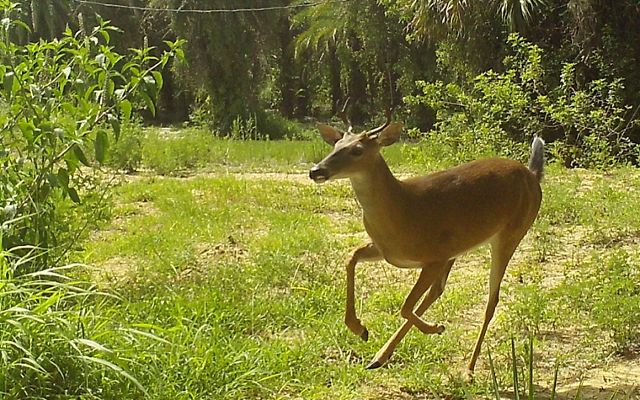Panther Breeding Area Expands in Partnership With Citrus Producer, G Road Grove LLC
The southwest Florida conservation easement protects habitat for endangered Florida panthers and other wildlife species.
Media Contacts
-
Carson Mitchell Pena
Phone: 352-318-2945
Email: carson.pena@tnc.org
The Nature Conservancy in Florida and the U.S. Department of Agriculture Natural Resources Conservation Service (NRCS) have partnered to purchase a conservation easement at G Road Grove, an active citrus grove and tree nursery in Florida panther habitat.
G Road Grove expands the protected area within the Florida Panther Dispersal Zone, a 30,000-acre corridor in Hendry and Glades counties that helps connect the panthers' current breeding population in areas south of the Caloosahatchee River to suitable habitat north of the river. G Road Grove is also part of the designated 18-million-acre Florida Wildlife Corridor, a network of connected lands and waters that span the state. With this conservation easement, TNC and NRCS are creating and supporting large areas for wildlife to feed, breed and roam. G Road Grove joins nearby conserved lands in this corridor, including the Spirit of the Wild Wildlife Management Area, Okaloacoochee Slough State Forest and several conservation easement lands, such as Black Boar Ranch, Lone Ranger Forge and Chaparral Slough.
Florida panthers rely on a network of protected, connected public and private lands to hunt and breed. They use this mosaic of lands, including ranch lands and other agricultural lands such as the citrus groves and tree nursery found on G Road Grove, as safe movement pathways and sources of food and water.
“Florida panthers help balance our ecosystems. The health of this species helps ensure we have stable wildlife populations and functioning natural areas,” said Wendy Mathews, Senior Conservation Projects Manager with The Nature Conservancy in Florida. “Florida panthers could be on the brink of extinction, surviving on less than 5% of their historic range. But by working with state and federal partners and private landowners to protect land, we can give panthers a chance at recovery. It’s critical that we urgently act to protect the lands panthers need to survive.”
The Florida panther population declined due to a loss of habitat, habitat fragmentation and human activities. State and federal agencies have stepped in to help manage the population, which mainly breeds in available habitat south of the Caloosahatchee River in southwest Florida. Successful management and land protection efforts have helped the population recover to approximately 200 panthers.


Along with large swaths of protected land, Florida panthers need reliable food sources. Agricultural lands are home to prey species including white-tailed deer, rabbits and raccoons. One of the panthers’ favorite prey species are non-native, invasive feral hogs, which are common across Florida.
TNC and the Florida Fish and Wildlife Conservation Commission (FWC) have found evidence of non-native, invasive feral hogs at G Road Grove, observing soil disturbance from foraging. Feral hogs typically travel in groups and can destroy acres of land in a single night as they forage for acorns, palmetto berries, small bugs and other food. Controlling non-native, invasive feral hogs requires intensive hunting and trapping, which is costly and labor intensive for land managers. But the best way to manage the hogs is through their predators: Florida panthers.
Non-native, invasive wildlife and plant species damage habitats that native Florida species need, taking up valuable food, space and water resources and causing an imbalance to natural systems. The landowner of G Road Grove plans to work on controlling non-native, invasive plants on the property with the help of NRCS for cost-share programs.
NRCS supports America’s farmers, ranchers and forest landowners by helping them make investments in their operations. They help keep working lands working, boost rural economies, increase the competitiveness of American agriculture and improve the quality of our air, water, soil and habitat.
“G Road Grove is a great example of NRCS leveraging local partnerships to protect wildlife habitat and the long-term viability of the nation’s food supply by preventing conversion of productive working lands to non-agricultural uses,” said Marcus Shorter, NRCS Assistant State Conservationist for Easements in Florida.
“The G Road Grove easement is a wonderful example of providing vital habitat and cover for endangered species while also maintaining productive farms. The citrus trees provide protected, unobstructed travel routes that are so critical to the Florida panther,” said Sara May, Agricultural Land Easement (ALE) Coordinator for NRCS in Florida. “Conservation easements protect land from future development while also allowing land management activities and uses, such as agricultural activities, to continue on the property. With a conservation easement, we permanently protect G Road Grove's agricultural uses and natural habitats.”
TNC in Florida supports conservation easements that protect lands, water resources and native plants and wildlife.
Florida panthers once roamed the southeastern United States but are now found only in parts of southwest and south-central Florida. The Florida panther was added to the state endangered list in 1958 and federally listed as endangered on the first federal Endangered Species List in 1967. By protecting more lands in the Florida Wildlife Corridor, TNC and our partners continue to support the Florida panther for generations to come.
The Nature Conservancy is a global conservation organization dedicated to conserving the lands and waters on which all life depends. Guided by science, we create innovative, on-the-ground solutions to our world’s toughest challenges so that nature and people can thrive together. We are tackling climate change, conserving lands, waters and oceans at an unprecedented scale, providing food and water sustainably and helping make cities more sustainable. The Nature Conservancy is working to make a lasting difference around the world in 81 countries and territories (40 by direct conservation impact and 41 through partners) through a collaborative approach that engages local communities, governments, the private sector, and other partners. To learn more, visit nature.org or follow @nature_press on X.
